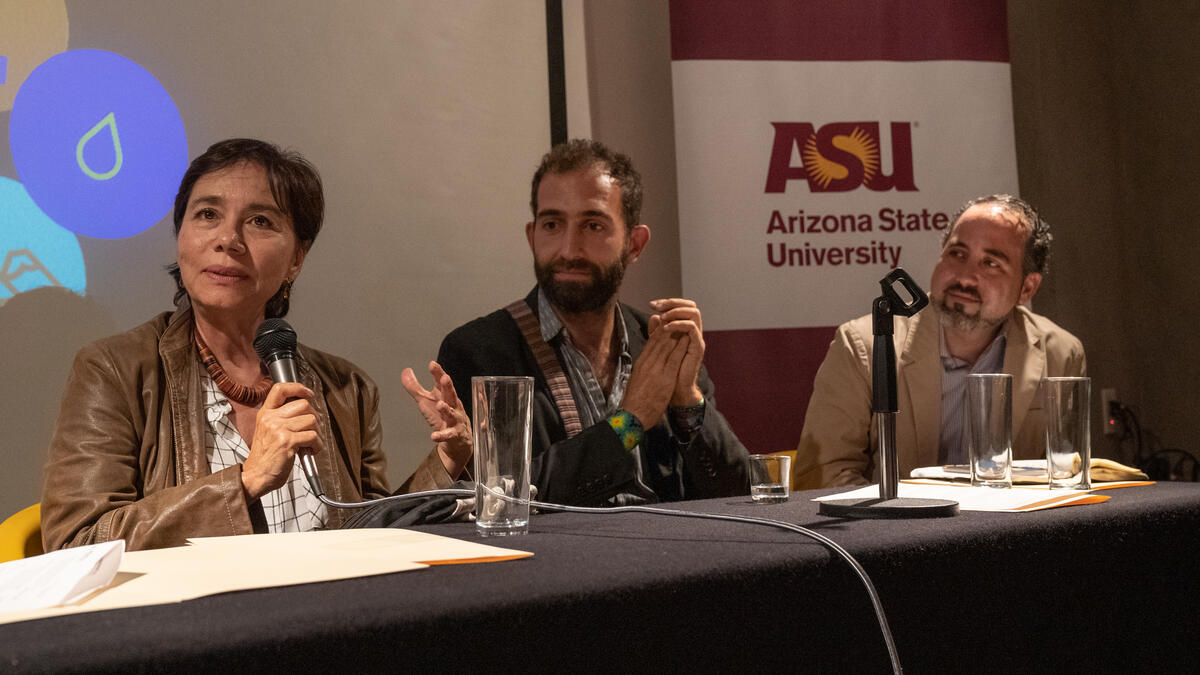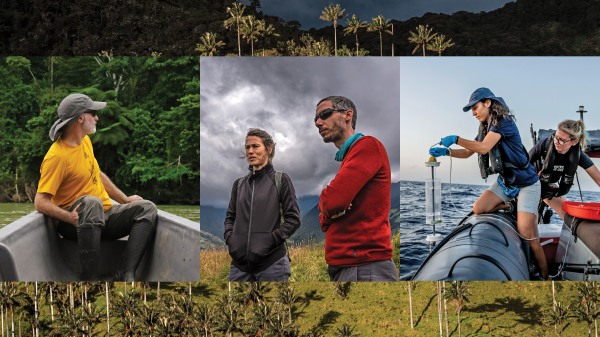Mexico, let’s talk water

From left: Marina Robles, Enrique Lomnitz and Enrique Vivoni at the "Mexico City Dehydrated?" panel in Mexico City last week. Photo by Speyside
Ever since its days as the imperial Aztec capital of Tenochtitlán, where efficient canals reminded invading Spaniards of Venice, Mexico City has had a complicated relationship with water. These days, the city’s underlying but dwindling water supply is literally sinking the city, and increased demand for water is intensifying issues of inequality and corruption. But the quest for water is also triggering civic and technological innovation, as well as a desire to collaborate with other parched regions.
These were some of the themes discussed at Arizona State University’s latest Convergence Lab event in Mexico City last week, “Mexico City Dehydrated?”, held at the Horizontal ideas journalism space.
In conversation with Horizontal Director Guillermo Osorno, Mexico City’s Secretary of the Environment Marina Robles said the metropolitan area’s 21 million people need to relearn “the relationship between nature and society,” and stop thinking that nature and the environment are foreign concepts, far removed from urban areas. Indeed, Robles added that over 50% of Mexico City is conservation land, providing the city with essential environmental services such as CO2 capture and the recharging of the aquifer that accounts for 70% of the city’s water. Similar to Phoenix’s Tres Rios Wetlands, Mexico City is also constructing artificial wetlands to support water treatment and groundwater recharge.
Of the “mountain of challenges” to Mexico City’s water security, not the least of which are leaky pipes that waste an estimated third of the city’s water supply, Robles argues that the most significant one may be people’s mindsets. While most people acknowledge the water crisis and think that action must be taken, they are hesitant to make personal changes when it impacts their own comfort.
ASU and the Universidad Nacional Autónoma de México, Mexico’s prestigious national university, have partnered up to create a modeling tool called MEGADAPT to help scientists and policymakers like Robles assess the scope of Mexico City’s water crisis, and how changes in policy and behavior affect it and shift vulnerabilities. Luis Bojórquez, UNAM’s lead researcher for MEGADAPT, told Robles and the audience that graduate sustainability studies at UNAM had been started over a decade ago as a result of interactions with ASU, and he pointed to projects like MEGADAPT and the ASU-UNAM Binational Laboratory on Climate Change Vulnerability as examples of pragmatic and essential cross-border research collaborations to confront shared North American challenges.
He and Enrique Vivoni, ASU professor and associate dean of the Graduate College, agreed that while scientists are fairly certain that the temperatures will continue rising, it isn’t immediately clear what that means for overall precipitation trends in cities like Mexico City, though we might expect more flooding from severe storms. Hence the need for cities to become far more resilient, to confront both severe weather fluctuations and uncertainty.
In addition to his own involvement with the MEGADAPT project, Vivoni is also focused on regional cooperation closer to home, between Arizona and the neighboring border state of Sonora to address shared issues of water conservation and sustainable economic development. Next spring students of his will respond to sustainability challenges posed by water and natural resource management agencies in northern Mexican communities from Ensenada, Mexicali, Hermosillo and Ciudad Juarez. Both he and Bojorquez stressed the need for more citizen engagement in meeting the environmental challenges our cities face; Vivoni went so far as to hold up his smartphone as a powerful technology in this effort, as citizens can be connected to scan, measure and map water quality and access.
One such civic enterprise in Mexico committed to preserving as much of the city’s rainfall as possible is Isla Urbana. Enrique Lomnitz, the group’s director, told the Convergence Lab audience that rainwater harvesting systems in Mexico City, where it rains regularly, can provide a family with water independence for 5 to 8 months out of the year. Since being founded in 2009, Isla Urbana has installed 15,000 catchment systems while reducing flooding, energy usage and pumping from aquifers. Isla Urbana has worked with ASU researchers to map potential rainwater harvesting locations and present them to Mexico City officials.
Referring to Mexico’s water challenges, Lomnitz said, “We are never going to solve this problem solely through government action,” particularly since conservation innovation will require risk-taking and experimentation. Robles agreed, though added that her government had taken significant actions to encourage conservation, such as enforcing a stricter water-usage code on new developments. Bojorquez focused on the societal implications, stressing that adaptation to climate change will have to occur in every sector, and will be an expensive process.
Depending on their individual perspectives, the Convergence Lab speakers emphasized the role of academic researchers, the private sector, and government agencies in leading efforts to ensure long-term water security in the face of mounting demand and adverse climate change. But as the evening wore on, it became increasingly clear that they all agreed on the need for greater cross-border collaboration to meet the shared challenges ahead.
Written by Margaret Tucker
More Environment and sustainability

A water fix that takes on the yuck factor
Written by Christy Spackman, an ASU assistant professor and senior global futures scientist. This essay is adapted with…

At home in the wild
By Kristin ToussaintEditor's note: This story is featured in the winter 2025 issue of ASU Thrive.Way up in the Andes mountains in…

Switching to 'green' plastic alone won’t solve the plastic problem, study shows
Plastic is everywhere. Today alone, you have probably already touched a whole lot of it, whether it’s your phone case, sunglasses…